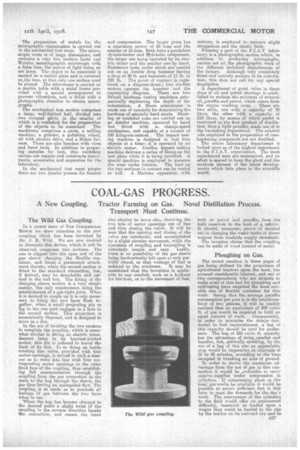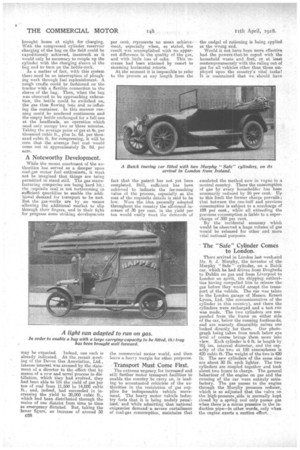COAL GAS PROGRESS.
Page 15

Page 16

If you've noticed an error in this article please click here to report it so we can fix it.
A New Coupling. Tractor Farming on Gas. Novel Distillation Process. Transport Must Continue.
The Wild Gas Coupling.
In a recent issue of THE COMMERCIAL Monet we drew attention to the new coupling which has been invented by Mr. J. E. Wild. We are now enabled to illustrate this device, which it. will be observed comprises two sections. The one is slipped into the open end of the gas sleeve charging the flexible container, and forms a permanent attachment thereto, while the second section is fitted to the standard donne.etion, but, if desired, may be detachable and carried in the tool box. The fitting of the charging sleeve section is a very simple matter, the only requirement being the establishment of a gas-tight joint. When it is desired to couple up it is only necessary to bring the two faces flush together, when a small projecting pin or lug in the one part engages in a hole in the second section. This projection is eccentrically disposed, and is designed to move in a slot.
In the act of twisting the two sections to complete the coupling, which is somewhat similar to fitting an electric incandescent lamp in its bayonet-jointed socket, thispm is induced to travel the limit of its slot. In so doing an inside rotating disc valve, provided with four sector-openings, is moved in such a manner as to come into line with four corresponding sector openings in the outer fixed face of the coupling, thus establish: ing full communication through the coupling from the gas connection to the main to the bag -through the sleeve, the gas thus having an unimpeded flow. The coupling is so made as to preclude all leakage of gas between the two faces when in use.
When the bas has become charged to the desired point a slight twist of the coupling in the reverse direction breaks the connection, and causes the inner
disc shutter to move also, throwing the two sets of sector openings out of line and thus closing the valve. It will be Seen that the opening and closing of the valve are automatic, and accomplished by a slight circular movement, while the operation of coupling and uncoupiing is extremely simple and easy. Lastly, there is no possibility of the gas sleeve being inadvertently left open or only partially closed, so that wastage of fuel is reduced to the minimum. It may be mentioned that the invention is applicable to any conduit, such as a hydrant for fire-hose, or to the movement of fuel,
such as petrol and paraffin, from the . bulk reservoir to the tank of a vehicle. It should, moreover, prove of decided nee in charging the water tanks of steam Wagons from roadside supply standards.
The inventor claims that the coupling can be made of wood instead of metal.
Ploughing on Gas.
The recent mention in these pages of gas being utilized for the propulsion of agricultural tractors Non the land, has arou.sed considerableanterest, and one or two correspondents who are anxious to make avail of this fuel for ploughing and cultivating have enquired the most suitable size of flexible container for this work. Seeing that the average paraffin consumption per acre is in the neighbourhood of two gallons, it will be readily realized that an equivalent of 500 cubic ft. of gas would be required to fulfil an equal amount of work. Consequently, in order to minimize the delays incidental to fuel replenishment, a bag of this capacity should be used for preference. The bag of 250 cubic ft. capacity has the advantage of being smaller and handier, but, generally speaking, by the use of a bag of this Me an appreciable stop would be imperatiereat intervals of 35 to 45 minutes, according to thetime occupied in breaking an acre of ground.
In order to derive the maximum advantage from the use of gas in. this connection it would be dreferable to carry reserve supplies under compression in cylinders: If compressing plant atthe local gas-works be available it would be possible to secure sufficient fuel in this farm to meet the demands for the day's work. The conveyance of the cylinders to the field would Offer no pronounced diffieulty, inasmuch as loaded upon a wagon they could be hauled to the site by the tractor on its outward run and be brought home at night for charging. With the compressed cylinder reservoir charging of the bag on the field could be• expeditiously achieved, inasmuch as it would only be necessary to couple up the cylinder with the charging sleeve of the bag and to tam on the bottle-cock.
As a matter of fact, with this system there need be no interruption of ploughing work through fuel_ replenishment. A rough cradle could be fashioned on the tractor with a flexible connection to the sleeve of the hag. . Then, when the bag was observed to be approaching exhaustion, the bottle could bp switched on, the gas thus flowing into and re-inflating the container. In this manner running could be rendered continuous and the empty bottle exchanged for a full one at the headlands, an operation which need only occupy two or three minutes. Taking the average price of gas at 4s. per thousand cubic ft., plus is. 6d. per thousand cubic ft. for compressing, it will be seen that the average fuel cost would came out at approximately 2s. 9d. per acre.
A Noteworthy .Development.
While the recent enactment of the authorities has served as a damper upon coal-gas motor fuel enthusiasts, it must not he imagined that things are being permitted to stand still. The gas manufacturing companies are being hard hit: the requisite coal, is not forthcoming in sufficient quantities to enable the additional demand for transport to be met. But the gas-works are by no means allowing the additional market to slip through their fingers, and in their fight for progress some striking developmants
may be expected. Indeed, one such is already indicated. At the, recent meeting of the Devon Gas Association, Ltd., intense interest was aroused by the statement of a director to the effect that by means of a new and novel process in distillation, which they had evolved, they had been able to lift the yield of gas per ton of coal from 11,500 to 14,000 cubic ft., and, indeed, had succeeded in increasing the yield to 20,000 cubic ft., which had been distributed through the mains of one district from time to time as emergency dictated. But, taking the lower figure, an increase of around 30
c38 per cent, represents no mean achievement, e,specially when, as stated, the result was accomplished with no apparent difference in the quality of the gas,
and with little loss of coke. This increase had been attained by resort to steaming horizontal retorts.
At the moment it is impossible to refer to the process at any length from the fact that the patent has not yet been completed. Still, sufficient has been achieved to indicate the far-reaching value . of the process, especially as the cost of the requisite details is said to be low. Were the idea generally adopted throughout the country the all-round increase of 30 per cent, in the yield per ton would easily meet the demands of the commercial motor world, and then leave a heavy margin for other purposes.
Transport Must Come First.
The extreme urgency, for increased and still further motor transport facilities to enable the country-to carry on, is leading to accentuated criticism of the authorities in the restriction of gas supplies for indispensable vehicle movement. The heavy motor vehicle industry feels that it is being unduly penalized, and while admitting that national exigencies demand a severe curtailment of coal-gas consumption, maintains that
the cudgel of rationing is being applied at the wrong end.
Would it not have been more effective had the powers-that-be coped with the honsehold waste end first, or at least contemporaneously with the ruling out of gas. for all vehicles other than those erm ployed upon the country's vital tasks? It is maintained that we, should have
emulated the method now in vogue in a neutral country. There the consumption of gas by every householder has been summarily reduced by 50 per cent. ilp to this limit the former charge prevails; that between the one-half and previous consumption is subject to a surcharge of 100 per cent., while all ekeeding the previous consumption is liable to a supercharge of 300 per cent. By the incidental economy which would be observed a huge volume of gas would be released for other and more vital national purposes.
• The "Safe" Cylinder Comes to London.
There arrived in London last week,and Mr. S. J. Murphy, the inventor of the Murphy " Safe ' cylinder, on a Buick car, which he had driven from Drogheda to Dublin an gas and from Liverpool to London on spirit, the shippingauthorities having compelled him to release -the gas before they would accept the transport of the vehicle. The car was taken to the London garage of Messrs. Ernest Lyons, Ltd. (the concessionnaires of the cylinder in this country), and there the cylinders were recharged and a test run was made. The two cylinders are suspended from the frame on either side of the car, below the running footboards, and are scarcely discernible unless one looked directly for them. Our photograph being taken from much below eye level of course brings them more into view. Each cylinder is 6 ft, in length by 10 ins, internal diameter, and the capacity af the two at 120 atmospheres is 420 cubic ft. The weight of the two is 420 lb. The new cylinders of the same size are about 30 lb. each lighter. The two cylinders are coupled together and took about two hours to charge. The general behaviour of the engine on gas and the running of the car were entirely satisfactory. The gas passes to the engine through the Murphy pressure reducer, which is so adjusted that the valve on the high-pressure ,sitle' is normally kept closed by a spring and only passes gas when there is a minus pressure in the inductionpipe—in other words' only when the engine exerts a suction effort.






















